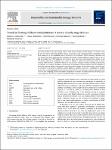Trends in floating offshore wind platforms: A review of early-stage devices
| dc.contributor.author | Edwards, EC | |
| dc.contributor.author | Holcombe, A | |
| dc.contributor.author | Brown, S | |
| dc.contributor.author | Ransley, E | |
| dc.contributor.author | Hann, M | |
| dc.contributor.author | Greaves, D | |
| dc.date.accessioned | 2024-01-23T10:32:10Z | |
| dc.date.available | 2024-01-23T10:32:10Z | |
| dc.date.issued | 2024-04 | |
| dc.identifier.issn | 1364-0321 | |
| dc.identifier.issn | 1879-0690 | |
| dc.identifier.other | 114271 | |
| dc.identifier.uri | https://pearl.plymouth.ac.uk/handle/10026.1/21928 | |
| dc.description.abstract |
This study reviews early-stage floating offshore wind turbine (FOWT) platform designs. The review covers 86 past and current early-stage platform designs, ranging from early conceptual designs to platforms which have undergone lab tests simulating extreme conditions. The evolution of FOWT platforms is described, and it is shown how FOWT platforms were originally influenced by floating platforms typically used in the oil and gas industry, but FOWT platforms have deviated away from these conventional floater designs to suit the specific needs of the technology. Four phases are defined to characterize chronological shifts in design thinking. There has been a number of alternative cost reduction strategies recently, including (i) specializing the platform to a particular location or environment, (ii) increasing manufacturability, and (iii) designing an innovative platform which diverges further from conventional designs. For the latter strategy, there has been an emergence of multi-turbine platforms, hybrid platforms, platforms which use a combination of stability mechanisms, and hydrodynamically specialized platforms. Finally, potential future trends are discussed, and it is shown that competing priorities for platform designers in the future will likely mean that the design space must compromise between increasing standardization and increasing specialization. | |
| dc.format.extent | 114271-114271 | |
| dc.language | en | |
| dc.publisher | Elsevier BV | |
| dc.relation.uri | https://doi.org/10.24382/scvw-0t77 | |
| dc.title | Trends in floating offshore wind platforms: A review of early-stage devices | |
| dc.type | Journal Article | |
| plymouth.volume | 193 | |
| plymouth.publication-status | Accepted | |
| plymouth.journal | Renewable and Sustainable Energy Reviews | |
| dc.identifier.doi | 10.1016/j.rser.2023.114271 | |
| plymouth.organisational-group | |Plymouth | |
| plymouth.organisational-group | |Plymouth|Research Groups | |
| plymouth.organisational-group | |Plymouth|Faculty of Science and Engineering | |
| plymouth.organisational-group | |Plymouth|Faculty of Science and Engineering|School of Engineering, Computing and Mathematics | |
| plymouth.organisational-group | |Plymouth|REF 2021 Researchers by UoA | |
| plymouth.organisational-group | |Plymouth|Users by role | |
| plymouth.organisational-group | |Plymouth|Users by role|Academics | |
| plymouth.organisational-group | |Plymouth|REF 2021 Researchers by UoA|UoA12 Engineering | |
| plymouth.organisational-group | |Plymouth|Users by role|Researchers in ResearchFish submission | |
| plymouth.organisational-group | |Plymouth|Research Groups|COAST Engineering Research Group | |
| plymouth.organisational-group | |Plymouth|REF 2028 Researchers by UoA | |
| plymouth.organisational-group | |Plymouth|REF 2028 Researchers by UoA|UoA12 Engineering | |
| dc.date.updated | 2024-01-23T10:32:09Z | |
| dc.rights.embargodate | 2024-01-24 | |
| dc.identifier.eissn | 1879-0690 | |
| rioxxterms.versionofrecord | 10.1016/j.rser.2023.114271 |


